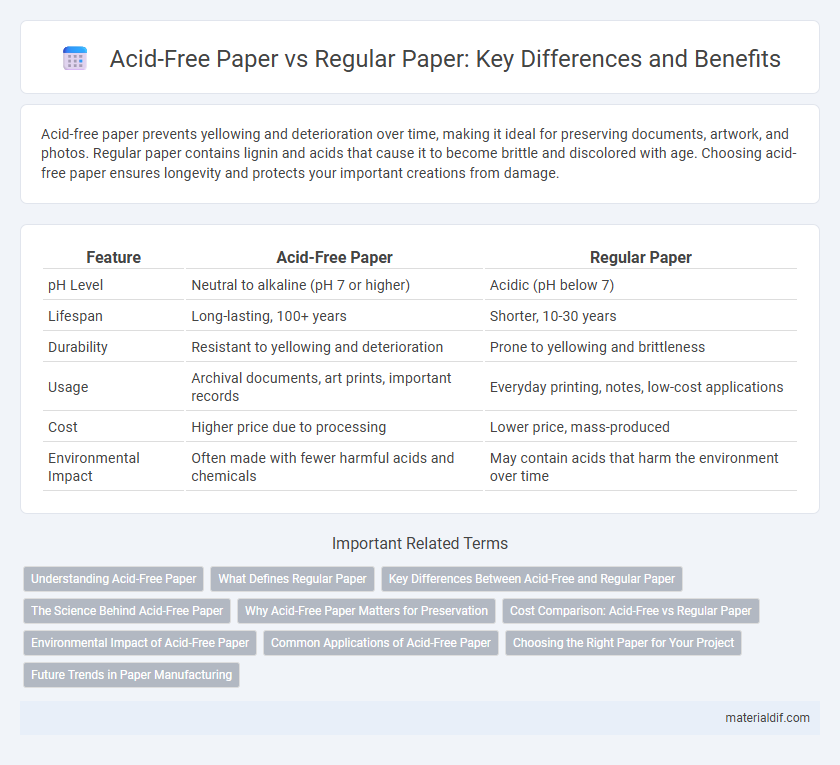Acid-free paper prevents yellowing and deterioration over time, making it ideal for preserving documents, artwork, and photos. Regular paper contains lignin and acids that cause it to become brittle and discolored with age. Choosing acid-free paper ensures longevity and protects your important creations from damage.
Table of Comparison
| Feature | Acid-Free Paper | Regular Paper |
|---|---|---|
| pH Level | Neutral to alkaline (pH 7 or higher) | Acidic (pH below 7) |
| Lifespan | Long-lasting, 100+ years | Shorter, 10-30 years |
| Durability | Resistant to yellowing and deterioration | Prone to yellowing and brittleness |
| Usage | Archival documents, art prints, important records | Everyday printing, notes, low-cost applications |
| Cost | Higher price due to processing | Lower price, mass-produced |
| Environmental Impact | Often made with fewer harmful acids and chemicals | May contain acids that harm the environment over time |
Understanding Acid-Free Paper
Acid-free paper is manufactured using neutral or alkaline substances to prevent the natural deterioration caused by acid content found in regular paper, ensuring long-term durability and resistance to yellowing. This paper is ideal for archival purposes, legal documents, and artwork, as it maintains integrity over decades without becoming brittle. Understanding the chemical composition and pH balance of acid-free paper is crucial for selecting materials that support preservation and longevity.
What Defines Regular Paper
Regular paper typically contains lignin, a natural component found in wood pulp, which causes it to yellow and become brittle over time due to acidification. This type of paper often has a lower pH level, usually acidic, leading to faster degradation compared to acid-free alternatives. The presence of acids accelerates oxidation and weakens the paper fibers, making regular paper less ideal for long-term preservation.
Key Differences Between Acid-Free and Regular Paper
Acid-free paper is manufactured using a neutral or alkaline pH process, preventing yellowing and deterioration over time, unlike regular paper, which often contains acidic compounds that cause it to become brittle and discolored. Acid-free paper typically contains calcium carbonate as a buffering agent, enhancing its longevity and suitability for archiving important documents and artwork. In contrast, regular paper is less durable due to its lower pH level and susceptibility to acid hydrolysis, impacting its preservation qualities.
The Science Behind Acid-Free Paper
Acid-free paper is manufactured using a neutral or slightly alkaline pH, typically around 7 to 9, which prevents the rapid degradation seen in regular paper containing acidic lignin and sulfur compounds. The alkaline buffer, often calcium carbonate, neutralizes acids formed during aging, enhancing the paper's durability and resistance to yellowing and brittleness. This scientific approach ensures acid-free paper maintains structural integrity for archival purposes, unlike conventional paper that breaks down faster due to acid-catalyzed hydrolysis of cellulose fibers.
Why Acid-Free Paper Matters for Preservation
Acid-free paper is essential for long-term preservation because it prevents yellowing, brittleness, and deterioration that acidic components cause in regular paper. It maintains the integrity of documents, artworks, and archival materials by neutralizing acids and providing a stable pH environment. Museums, libraries, and conservation experts prioritize acid-free paper to ensure the durability and longevity of valuable records and collections.
Cost Comparison: Acid-Free vs Regular Paper
Acid-free paper typically costs 20% to 50% more than regular paper due to its higher-quality materials and longer lifespan. While regular paper's lower price suits short-term projects, acid-free paper's durability and resistance to yellowing justify the premium for archival documents and fine art. Investing in acid-free paper reduces long-term replacement costs and maintains the integrity of important prints and documents.
Environmental Impact of Acid-Free Paper
Acid-free paper significantly reduces environmental harm by using chemical processes that avoid acidic compounds, which prevents paper from becoming brittle and decomposing into harmful substances over time. This sustainable production method extends the longevity of paper products, minimizing waste and reducing the frequency of replacement compared to regular acidic paper. The recyclable and archival qualities of acid-free paper contribute to lower deforestation rates and decreased landfill accumulation, promoting better environmental conservation.
Common Applications of Acid-Free Paper
Acid-free paper is widely used in archival documents, art prints, and important manuscripts due to its longevity and resistance to yellowing and deterioration. Museums, libraries, and photographers prefer acid-free paper for preserving valuable materials and artworks over extended periods. Common applications also include scrapbooking, legal documents, and premium stationery, ensuring durability and color retention.
Choosing the Right Paper for Your Project
Choosing the right paper for your project depends on factors like longevity, purpose, and environmental impact. Acid-free paper is ideal for archival documents, artwork, and important projects because it resists yellowing and deterioration over time. Regular paper, typically more affordable, suits everyday printing but may degrade faster, affecting the durability and appearance of your final product.
Future Trends in Paper Manufacturing
Future trends in paper manufacturing emphasize the increased adoption of acid-free paper due to its enhanced durability and environmental benefits. Advances in sustainable production methods, such as chlorine-free bleaching and recycled fiber integration, are driving the shift away from regular paper with high acid content. Emerging technologies focus on improving the longevity and archival quality of acid-free paper, meeting the growing demand from publishing, art, and legal industries.
Acid-Free Paper vs Regular Paper Infographic

 materialdif.com
materialdif.com